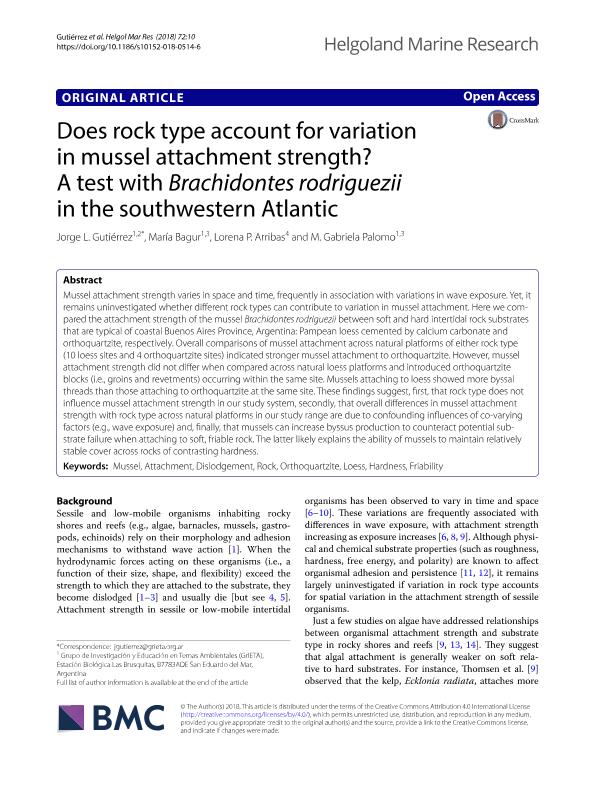Mostrar el registro sencillo del ítem
dc.contributor.author
Gutierrez, Jorge Luis Ceferino

dc.contributor.author
Bagur, María
dc.contributor.author
Arribas, Lorena Pilar

dc.contributor.author
Palomo, Maria Gabriela

dc.date.available
2020-03-25T16:16:26Z
dc.date.issued
2018-06
dc.identifier.citation
Gutierrez, Jorge Luis Ceferino; Bagur, María; Arribas, Lorena Pilar; Palomo, Maria Gabriela; Does rock type account for variation in mussel attachment strength? A test with Brachidontes rodriguezii in the southwestern Atlantic; Springer; Helgoland Marine Research; 72; 1; 6-2018; 1-11
dc.identifier.issn
1438-387X
dc.identifier.uri
http://hdl.handle.net/11336/100703
dc.description.abstract
Mussel attachment strength varies in space and time, frequently in association with variations in wave exposure. Yet, it remains uninvestigated whether different rock types can contribute to variation in mussel attachment. Here we compared the attachment strength of the mussel Brachidontes rodriguezii between soft and hard intertidal rock substrates that are typical of coastal Buenos Aires Province, Argentina: Pampean loess cemented by calcium carbonate and orthoquartzite, respectively. Overall comparisons of mussel attachment across natural platforms of either rock type (10 loess sites and 4 orthoquartzite sites) indicated stronger mussel attachment to orthoquartzite. However, mussel attachment strength did not differ when compared across natural loess platforms and introduced orthoquartzite blocks (i.e., groins and revetments) occurring within the same site. Mussels attaching to loess showed more byssal threads than those attaching to orthoquartzite at the same site. These findings suggest, first, that rock type does not influence mussel attachment strength in our study system, secondly, that overall differences in mussel attachment strength with rock type across natural platforms in our study range are due to confounding influences of co-varying factors (e.g., wave exposure) and, finally, that mussels can increase byssus production to counteract potential substrate failure when attaching to soft, friable rock. The latter likely explains the ability of mussels to maintain relatively stable cover across rocks of contrasting hardness.
dc.format
application/pdf
dc.language.iso
eng
dc.publisher
Springer

dc.rights
info:eu-repo/semantics/openAccess
dc.rights.uri
https://creativecommons.org/licenses/by/2.5/ar/
dc.subject
ATTACHMENT
dc.subject
DISLODGEMENT
dc.subject
FRIABILITY
dc.subject
HARDNESS
dc.subject
LOESS
dc.subject
MUSSEL
dc.subject
ORTHOQUARTZITE
dc.subject
ROCK
dc.subject.classification
Biología Marina, Limnología

dc.subject.classification
Ciencias Biológicas

dc.subject.classification
CIENCIAS NATURALES Y EXACTAS

dc.subject.classification
Ecología

dc.subject.classification
Ciencias Biológicas

dc.subject.classification
CIENCIAS NATURALES Y EXACTAS

dc.title
Does rock type account for variation in mussel attachment strength? A test with Brachidontes rodriguezii in the southwestern Atlantic
dc.type
info:eu-repo/semantics/article
dc.type
info:ar-repo/semantics/artículo
dc.type
info:eu-repo/semantics/publishedVersion
dc.date.updated
2020-03-25T14:00:09Z
dc.journal.volume
72
dc.journal.number
1
dc.journal.pagination
1-11
dc.journal.pais
Alemania

dc.journal.ciudad
Berlin
dc.description.fil
Fil: Gutierrez, Jorge Luis Ceferino. Universidad Nacional de Mar del Plata. Facultad de Ciencias Exactas y Naturales. Departamento de Biología; Argentina. Consejo Nacional de Investigaciones Científicas y Técnicas. Centro Científico Tecnológico Conicet - Mar del Plata; Argentina
dc.description.fil
Fil: Bagur, María. Consejo Nacional de Investigaciones Científicas y Técnicas. Oficina de Coordinación Administrativa Parque Centenario. Museo Argentino de Ciencias Naturales "Bernardino Rivadavia"; Argentina
dc.description.fil
Fil: Arribas, Lorena Pilar. Consejo Nacional de Investigaciones Científicas y Técnicas. Centro Científico Tecnológico Conicet - Centro Nacional Patagónico. Instituto de Biología de Organismos Marinos; Argentina
dc.description.fil
Fil: Palomo, Maria Gabriela. Consejo Nacional de Investigaciones Científicas y Técnicas. Oficina de Coordinación Administrativa Parque Centenario. Museo Argentino de Ciencias Naturales "Bernardino Rivadavia"; Argentina
dc.journal.title
Helgoland Marine Research

dc.relation.alternativeid
info:eu-repo/semantics/altIdentifier/url/https://hmr.biomedcentral.com/articles/10.1186/s10152-018-0514-6
dc.relation.alternativeid
info:eu-repo/semantics/altIdentifier/doi/http://dx.doi.org/10.1186/s10152-018-0514-6
Archivos asociados
